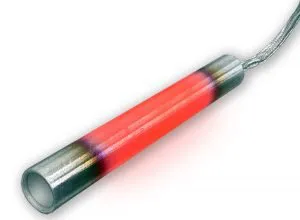Cartridge Heaters: Minimizing Failures
There are several bad things you can do to a cartridge heater (any heater actually) that may damage it or shorten its life. In this installment of Ask Ian, we look at heater abuse and things to avoid.
 Don’t let contamination get onto a heater, especially near the lead-wires or screw terminals. Even a dry contaminant could liquefy when heated and get to where it’s not supposed to. I have no idea if chocolate is conductive or not, and I don’t particularly want to find out by having powdered cocoa on the armored section of the lead-wires melt and onto the lead-wires within. It’s probably a nice smell for a few minutes, yes, but probably not good for the heater.
Don’t let contamination get onto a heater, especially near the lead-wires or screw terminals. Even a dry contaminant could liquefy when heated and get to where it’s not supposed to. I have no idea if chocolate is conductive or not, and I don’t particularly want to find out by having powdered cocoa on the armored section of the lead-wires melt and onto the lead-wires within. It’s probably a nice smell for a few minutes, yes, but probably not good for the heater.
Try to hold and transport heaters by handling the heater body. It’s very tempting to handle a heater by its lead-wires, and often there’s no problem in doing so, but it’s good to get into a habit of handling heaters by their bodies to avoid possible damage to the lead wire connections. If the heater was powered, obviously, wait for the heater to cool down before handling!
A heater that is moving while operating will put stress on the lead-wires. This could be as simple as repetitive movement or abrasion against a static object. Even slight abrasion can result in lead wire damage, not due to the force of the abrasion but the repetition of it. Even the strongest wire will fail after enough repetitive abrasion. A good solution is to specify the heater with some lead-wire protection. There is simple fiberglass sleeving (which will eventually wear away too), and stainless-steel braid or stainless-steel armor along with a few other options. The last two choices (the stainless-steel ones) will last longer. If the wire is not abrading against anything, the simple movement can lead to breakage in the actual wire from the repetitive movement. Specify a lead-wire length that is long enough for the wire to drape and hang as low as it can, preferably to a flat surface. Try to have the wire loop from the heater at least twice on that surface before traveling off to the power source.
Aside from contamination and damage caused by movement, one of the worst things for a heater is heat. That sounds counterintuitive, but if heat can be pulled away from a heater via conduction (the best method of heat transfer for most applications) then the heater will operate at a cooler temperature and last longer. Proper fitting holes for the cartridge heater, voltage control, and a safe ramp rate will keep the heater within safe operating temperatures.
We are here and happy to help with any technical questions related to our heaters and your application. We look forward to working with you.
